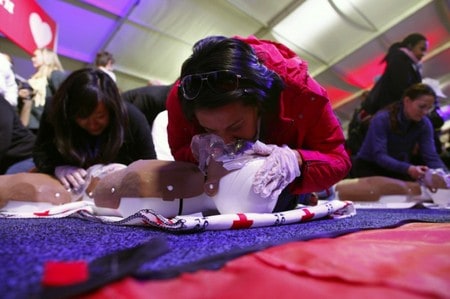By Lisa Rapaport
(Reuters Health) – To help more patients survive cardiac arrest, traditional CPR training needs an overhaul with more chances for practice – and instructions on social and digital platforms might help lessons stick, some doctors argue.
Few Americans are trained in cardiopulmonary resuscitation, or CPR, and many people who do learn how to do this don’t practice or take refresher courses over the years to keep their skills fresh. Improving CPR training might help people retain these lessons longer and increase the long odds that cardiac arrest patients survive long enough to leave a hospital.
“The delivery of high quality CPR is one of the most critical components to improve survival from cardiac arrest,” said Dr. Adam Cheng, lead author of new CPR training recommendations from the American Heart Association (AHA).
Cardiac arrest involves the abrupt loss of heart function, breathing and consciousness. Unlike a heart attack, which happens when blood flow to a portion of the heart is blocked, cardiac arrest occurs when the heart’s electrical system malfunctions, disrupting the heart’s rhythm or halting it altogether. Cardiac arrest may occur with no warning and is often fatal.
Chest compressions or CPR can help restore circulation, increasing the odds of survival. Bystander CPR generally won’t restore a normal heart rhythm, but it can buy time by maintaining blood flow to vital organs.
“We need to do a better job of communicating the importance of high quality CPR, and working with policy makers to ensure CPR training becomes a mandatory part of school curriculum as kids are growing up,” Cheng, of the University of Calgary in Canada, said by email.
With new recommendations for CPR training, the AHA is striving to double survival rates from cardiac arrest to 38 percent when the arrest happens in a hospital and to 15.8 percent when it happens outside a hospital by 2020. They’re also trying to double the proportion of cases when bystanders perform CPR until an ambulance arrives to 62 percent by 2020.
The AHA argues that learners should get shorter, more frequent practice instruction sessions to help them retain knowledge, receive regular structured feedback, and training experiences tied to real world situations.
Beyond this, faculty coaching is key, and instruction might benefit from gamification, social and digital media to help learners retain what they’re taught, according to the guidelines published in Circulation.
Among other things, the guidelines stress that CPR learners should practice until they demonstrate mastery of skills, and be assessed using a variety of tools throughout their CPR course to make sure they’re grasping the material.
Instructors should also get continuous coaching and training to make sure they’re using the latest and most effective tools available to reach students.
The new CPR training approach should be used for all types of learners, whether they’re medical professionals or high school students or people in the community.
Doctors, nurses and other health professionals might benefit from better feedback in CPR training because clinicians often overestimate how well they have mastered new skills, said Dr. Lorrel Brown of the University of Louisville School of Medicine, who directs the CPR advocacy group Alive in 5 (www.alivein5.org).
For a layperson, however, the main issue with CPR training is that it’s too expensive to justify the cost when they don’t need to know CPR for work, Brown said by email.
“Of course, there is more research to be done on improving survival following cardiac arrest, preventing cardiac arrest in the first place, and early recognition of victims so they get help quickly,” Brown said. “However, the low-hanging fruit in the field is simply getting more victims to have higher quality CPR – that is the single most modifiable factor influencing survival.”
SOURCE: http://bit.ly/2Ldszua Circulation, online June 21, 2018.


